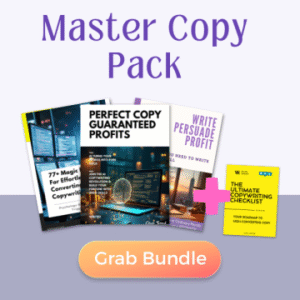Are you wondering how do I start learning copywriting? You’re in the right place. Copywriting is one of the most valuable skills in today’s digital economy. This complete guide will walk you through everything you need to know to begin your copywriting journey. From essential skills to practical exercises, we cover the exact steps to transform you from a complete beginner to a confident copywriter.
What is copywriting and why should you learn it?
Copywriting is the art of writing text for marketing purposes. It aims to increase brand awareness and persuade people to take a specific action. These actions include making a purchase, clicking on a link, donating to a cause, or scheduling a call.
The demand for skilled copywriters continues to grow as businesses compete for attention online. Learning copywriting opens doors to freelance opportunities, remote work, and high-paying careers. Even better, you can start learning right now without expensive degrees or certifications.
But how do I start learning copywriting if I have no experience? The journey begins with understanding the fundamental principles and practicing consistently. Anyone can learn this valuable skill with the right approach and resources.
Recommended reading:
- How to Learn Copywriting: A Step-by-Step for Success
- Copywriting beginner 10 simple steps to Master the essential
- Is copywriting easy for beginners? The truth about starting out
- How much a beginner copywriter earn? Entry-level compensation
Essential skills needed for successful copywriting
Before diving into how to learn copywriting, understand the core skills that make a great copywriter:
- Research abilities – You must learn to research audiences, products, and competitors thoroughly.
- Empathy – Understanding your audience’s needs, desires, and pain points is crucial.
- Clear communication – Expressing complex ideas in simple terms sets top copywriters apart.
- Persuasion techniques – You need to guide readers toward a specific action without being pushy.
- Creativity – Finding fresh angles and unique approaches helps your copy stand out.
- Editing skills – Great copy comes from ruthless editing and refinement.
- Adaptability – Different formats and audiences require different writing styles.
- Analytical thinking – Testing and improving your copy requires data analysis and critical thinking.
These skills develop over time, but awareness of them will guide your learning journey.
Step-by-step learning path for beginners
If you’re asking yourself “how do I start learning copywriting from scratch?” follow this strategic path:
Step 1: Understand copywriting fundamentals
Start by learning the core principles of effective copywriting:
- The purpose of headlines, subheadings, and body copy
- Features versus benefits (and why benefits matter more)
- Understanding customer pain points and desires
- Basic persuasion frameworks (like AIDA: Attention, Interest, Desire, Action)
- The importance of clarity and simplicity
Step 2: Study successful copy
Collect examples of copy that made you take action. Analyze what worked and why it affected you. Study:
- Email newsletters you open and read
- Social media ads you click on
- Sales pages that convinced you to buy
- Product descriptions that made you want something
Create a swipe file (collection of effective copy examples) for reference and inspiration.
Step 3: Learn the different types of copywriting
Familiarize yourself with various formats:
- Email copy
- Website copy
- Social media copy
- Ad copy
- Product descriptions
- Landing pages
- Sales letters
- Video scripts
Each format has unique requirements and techniques. Start with one or two that interest you most.
Step 4: Practice writing daily
Consistent practice builds your skills faster than anything else:
- Rewrite existing ads or product descriptions
- Create mock projects for imaginary businesses
- Write headlines for different products or services
- Practice explaining complex products in simple terms
Set a daily writing goal, even if it’s just 30 minutes.
Step 5: Get feedback on your work
Find ways to receive constructive criticism:
- Join copywriting communities and forums
- Find a mentor or coach if possible
- Take courses with feedback components
- Offer free work to small businesses in exchange for feedback
External perspectives reveal blind spots in your writing.
Top resources for learning copywriting
Books
Start with these foundational copywriting books:
- “The Copywriter’s Handbook” by Robert Bly
- “Breakthrough Advertising” by Eugene Schwartz
- “Everybody Writes” by Ann Handley
- “Hey, Whipple, Squeeze This” by Luke Sullivan
- “Scientific Advertising” by Claude Hopkins
Online courses
These courses provide structured learning:
- CopyHackers Copy School
- AWAI’s Accelerated Program for Six-Figure Copywriting
- Copyblogger’s Content Marketing Certification
- Copyhour by Derek Johanson
- The Copywriter Club courses
Websites and blogs
Bookmark these resources for ongoing learning:
- Copyblogger
- CopyHackers
- Enchanting Marketing
- Copyhour
- American Writers & Artists Institute (AWAI)
YouTube channels
Visual learners benefit from these channels:
- Alex Cattoni
- Neville Medhora
- Dan Lok
- The Futur
- Harmon Brothers
Podcasts
Listen while commuting or exercising:
- The Copywriter Club Podcast
- Hot Copy Podcast
- The Copywriter Underground
- Marketing School
- Copywriters Podcast
Practical exercises to develop copywriting skills
Theory alone won’t make you a copywriter. Try these exercises:
Exercise 1: Product benefit transformation
Pick a common product. List its features, then transform each feature into a benefit. Then transform each benefit into an emotional benefit.
Example:
- Feature: This pen has waterproof ink.
- Benefit: Your notes remain readable even if they get wet.
- Emotional benefit: Feel confident knowing your important ideas stay preserved no matter what happens.
Exercise 2: Headline workshop
Pick a product or service. Write 25 different headlines for it. This forces creativity and helps you break through obvious ideas.
Exercise 3: Rewrite existing copy
Find a mediocre product description online. Rewrite it to make it more compelling without changing the facts.
Exercise 4: Buyer persona development
Create detailed personas for a product’s target audience. Include demographics, goals, challenges, and objections. Then write copy addressing their specific needs.
Exercise 5: Copy dissection
Take successful sales pages or emails. Break them down paragraph by paragraph. Identify the purpose of each section and how it moves the reader forward.
Exercise 6: AIDA practice
Write copy using the AIDA framework:
- Attention: Grab interest with an opening line
- Interest: Build engagement with relevant information
- Desire: Create emotional connection and want
- Action: Prompt a clear next step
Try applying this to different products and services.
Finding your first clients and building a portfolio
After learning the basics, you need real-world experience:
Start with practice projects
Create mock projects for businesses you admire or fictional companies. These showcase your abilities even without paid work.
Offer free work strategically
Approach small businesses or nonprofits with specific copy problems you can solve. Exchange your services for testimonials and portfolio pieces.
Leverage your network
Tell friends, family, and colleagues you’re learning copywriting. Someone likely needs help with emails, website text, or other copy.
Create profiles on freelance platforms
Sites like Upwork, Fiverr, and Freelancer offer entry-level opportunities:
- Start with smaller projects to build reviews
- Price competitively while building experience
- Over-deliver to earn strong testimonials
Cold pitching
Identify businesses with subpar copy and pitch specific improvements:
- Focus on results, not just prettier words
- Show understanding of their business goals
- Make the pitch itself a sample of your copywriting skills
Content platforms
Write on Medium or LinkedIn to demonstrate your expertise and attract clients organically.
Common mistakes beginners make and how to avoid them
Learn from others’ missteps to accelerate your progress:
Mistake 1: Focusing on cleverness over clarity
Always prioritize being understood over being impressive. Clever wordplay that confuses the reader fails the primary purpose of copy.
Mistake 2: Not researching thoroughly enough
Great copy comes from deep understanding. Never skip the research phase, no matter how familiar you think you are with the topic.
Mistake 3: Writing for everyone
Targeting everyone means connecting with no one. Define your specific audience and write directly to them.
Mistake 4: Overcomplicating the message
Simple words and short sentences work best. If you need technical terms, explain them clearly.
Mistake 5: Neglecting the call to action
Every piece of copy should direct the reader toward a specific next step. Make this action clear and compelling.
Mistake 6: Ignoring the importance of formatting
Even brilliant words fail when presented as intimidating text blocks. Use subheadings, bullet points, and white space effectively.
Mistake 7: Not testing different approaches
The first version is rarely the best. Create multiple versions and test which performs better.
Setting realistic expectations and timeline
How long does it take to learn copywriting? The answer varies, but here’s a realistic timeline:
1-3 months: Foundation building
During this period, focus on understanding principles, studying examples, and practicing basic techniques. You’ll start recognizing good and bad copy but may struggle to produce quality work consistently.
3-6 months: Developing competence
With consistent practice, you’ll create increasingly effective copy. You can handle simple projects for clients but may need multiple revisions.
6-12 months: Growing confidence
Your skills sharpen noticeably. You develop a process for approaching projects and can handle more complex assignments. Clients see measurable results from your work.
1-2 years: Professional level
You consistently produce effective copy across various formats. You understand different audiences and know how to adapt your approach. You can command professional rates for your expertise.
Remember that this timeline assumes regular practice and study. Consistency matters more than intensity.
Your next steps to copywriting success
The journey of learning copywriting begins with a single step. Today, commit to these actions:
- Choose one book or course from the resources section to start your education.
- Set up a daily writing practice, even if it’s just 15 minutes.
- Create a swipe file and add at least five examples of copy that influenced you.
- Join one copywriting community online to connect with others on the same path.
- Complete one practical exercise from this guide.
Learning copywriting takes time and practice, but the rewards are substantial. Whether you want a lucrative side hustle, a full career change, or simply to improve your professional communication, copywriting skills deliver tremendous value.
If you’ve been wondering “how do I start learning copywriting?” now you have your answer: start small, practice consistently, study the masters, and apply what you learn. The journey of a thousand miles begins with a single word. Write it today.
Remember, every expert was once a beginner. Your copywriting journey starts now. Take that first step.

